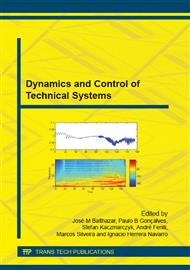[1]
A. P. M. Chiaradia, H. K. Kuga, H. K., B. Y. P. L. Masago, Short arcs orbit determination using GPS, Proceedings of ICOVP-2013, 11th International Conference on Vibration Problems, Lisbon, Portugal, Sep. 9-12, (2013).
Google Scholar
[2]
A. P. M. Chiaradia, H. K. Kuga, H. K, A. F. B. A. Prado, Onboard and real-time artificial satellite orbit determination using GPS, Mathematical Problems in Engineering, 2013, doi: 10. 1155/2013/530516.
DOI: 10.1155/2013/530516
Google Scholar
[3]
A. P. M. Chiaradia, H. K. Kuga, A. F. B. A. Prado, Comparison between Two Methods to Calculate the Transition Matrix of Orbit Motion, Mathematical Problems in Engineering, 2012, doi: 10. 1155/2012/768973.
DOI: 10.1155/2012/768973
Google Scholar
[4]
A. P. M. Chiaradia, H. K. Kuga, A. F. B. A. Prado, Single Frequency GPS measurements in real-time artificial satellite orbit determination, Acta Astronautica 53(2): 123-133, July (2003).
DOI: 10.1016/s0094-5765(02)00198-4
Google Scholar
[5]
K. Gold, W. L. Bertiger, S. Wu, T. Yunck, R. Mullerschoen, G. Born, K. Larson, A study of real-time GPS orbit determination for the extreme ultraviolet explorer, National Technical Meeting Proceedings of ION, Jan., (1994).
DOI: 10.1002/j.2161-4296.1994.tb01884.x
Google Scholar
[6]
L. L. Fu, E. J. Christensen, C. A. Yamarone Jr., M. Lefevre, Y. Ménard, M. Dorrer, P. Escudier, TOPEX/POSEIDON mission overview, Journal of Geophysical Research, 99(C12): 24369-24381, Dec., (1994).
DOI: 10.1029/94jc01761
Google Scholar
[7]
O. Montenbruck, E. Gill, Satellite orbits – models, methods, and applications. Springer Verlag, Heidelberg, (2000).
Google Scholar
[8]
E. Gill, O. Montenbruck, Th. Terzibaschian, An autonomous navigation system for the german small satellite mission BIRD, AAS/AIAA Space Flight Mechanics Meeting, AAS00-122, Jan., (2000).
Google Scholar
[9]
H. J. Rim, C. E. Webb, B. E. Schutz, Comparison of GPS-based precision orbit determination approaches for ICESAT, AAS/AIAA Space Flight Mechanics Meeting, AAS00-114, Jan., (2000).
DOI: 10.2514/6.2000-4234
Google Scholar
[10]
B. Haines, W. Bertiger, S. Desai, D. Kuang. T. Munson, A. Reichert, L. Young, P. Willis, Initial Orbit Determination Results for Jason-1 towards a 1-cm orbit, Proceedings of the ION GPS 2002, Portland, Oregon, USA, (2002).
DOI: 10.1002/j.2161-4296.2003.tb00327.x
Google Scholar
[11]
S. B. Luthcke, N. P. Zelensky, D. D. Rowlands, F. G. Lemoine, T. A. Williams, The 1-Centimeter Orbit: Jason-1 Precision Orbit Determination Using GPS, SLR, DORIS, and Altimeter Data, Marine Geodesy, 26: 399–421, 2003. doi: 10. 1080/01490410390256727.
DOI: 10.1080/714044529
Google Scholar
[12]
K. R. Choi, J. C. Ries, B. D. Tapley, JASON-1 precision orbit determination by combining SLR and DORIS with GPS tracking data, Marine Geodesy 27(1–2): 319–331, (2004).
DOI: 10.1080/01490410490465652
Google Scholar
[13]
D. Kuang, Y. Bar-Sever, W. Bertiger, S. Desai, B. Haines, B. Iijima, G. Kruizinga, T. Meehan, L. Romans, Precision orbit determination for CHAMP using GPS data from BlackJack receiver, Proceedings of the ION national technical meeting 2001, Long Beach, January, (2001).
DOI: 10.1109/plans.2008.4570030
Google Scholar
[14]
S. Zhu, C. Reigber, R. Koenig, Integrated adjustment of CHAMP, GRACE and GPS data, Journal of Geodesy 78(1–2): 103–108, (2004).
DOI: 10.1007/s00190-004-0379-0
Google Scholar
[15]
Z. Kang, P. Nagel, R. Pastor, Precise orbit determination for GRACE, Adv. Space Research 31: 1875–1881, (2003).
DOI: 10.1016/s0273-1177(03)00159-5
Google Scholar
[16]
Z. Kang, B. D. Tapley, S. Bettadpur, J. Ries, P. Nagel, R. Pastor, Precise orbit determination for the GRACE mission using only GPS data, Journal of Geodesy, 80(6): 322-331, 2006, doi: 10. 1007/s00190-006-0073-5.
DOI: 10.1007/s00190-006-0073-5
Google Scholar
[17]
B. S. Lee, J. C. Yoon, Y. Hwang, J. Kim, Orbit determination system for the KOMPSAT-2 using GPS measurement data, Acta Astronautica 57(9): 747-753, 2005, doi: 10. 1016/j. actaastro. 2005. 03. 066.
DOI: 10.1016/j.actaastro.2005.03.066
Google Scholar
[18]
B. S. Lee, J. S. Lee, J. H. Kima, S. P. Lee, J. C. Yoon, K. M. Roh, E. S. Park, K. H. Choi, Reconstruction of KOMPSAT-l GPS navigation solutions using GPS data generation and preprocessing program, Acta Astronautica 54: 571–576, (2004).
DOI: 10.1016/s0094-5765(03)00230-3
Google Scholar
[19]
H. K. Kuga, R. R. Kondapalli, Satellite Orbit Determination: A First-Hand Experience with the First Brazilian Satellite SCD1, 44th. Congress of the IAF, Graz, Austria, October (1993).
Google Scholar
[20]
V. Orlando, R. V. F. Lopes, H. K. Kuga, INPE's Flight Dynamics Team Experience throughout Four Years of SCD1 In-Orbit Operations: Main Issues, Improvements and Trends, ESA International Symposium on Spaceflight Dynamics, ESA, Darmstadt, Germany, June (1997).
Google Scholar
[21]
H. K. Kuga, V. Orlando, R. V. F. Lopes, Flight Dynamics Operations During Leop for the INPE's Second Environmental Data Collecting Satellite SCD2, Journal of Brazilian Society of Mechanical Sciences and Engineering XXI: 339-344, (1999).
Google Scholar
[22]
V. Orlando, H. K. Kuga, Os Satélites SCD1 e SCD2 da Missão Espacial Completa Brasileira– MECB (The satellites SCD1 and SCD2 from Full Brazilian Space Mission, in: O. C. Winter, A. F. B. A. Prado (Eds. ), A Conquista do Espaço - Do Sputnik à Missão Centenário (in portuguese), Editora Livraria da Física, São Paulo, 2007, pp.151-176.
Google Scholar
[23]
H. K. Kuga, V. Orlando, Orbit Control of CBERS-1 Satellite at INPE, Proceedings of 16th International Symposium on Spaceflight Dynamics, JPL/NASA, Pasadena, USA, (2001).
Google Scholar
[24]
V. Orlando, H. K. Kuga, J. Tominaga, CBERS-2 LEOP Orbit Analysis, Proceedings of 18th International Symposium on Spaceflight Dynamics, Munich, Germany, (2004).
Google Scholar
[25]
INPE, http: /www. inpe. br/ Access online on 3rd Jun., (2013).
Google Scholar
[26]
S. Pines, Uniform representation of the gravitational potential and its derivatives, AIAA Journal, 11(11), (1973).
DOI: 10.2514/3.50619
Google Scholar
[27]
International Earth Rotation Service (IERS). 1995 IERS Annual Report. Observatoire de Paris, Paris, (1996).
Google Scholar
[28]
H. W. Press, B. P. Flannery, S. A. Teukolsky, W. T. Vetterling, Numerical Recipes, Cambridge, University Press, 3rd. ed., (1987).
Google Scholar


